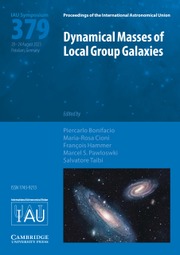No CrossRef data available.
Article contents
Kinematics of the diffuse intragroup/intracluster light in groups and clusters of galaxies in the Local Universe (within 100 Mpc)
Published online by Cambridge University Press: 06 October 2025
Abstract
Nearly all intragroup (IGL) and intracluster light (ICL) comes from stars that are not bound to any single galaxy but were formed in galaxies and later unbound from them. Kinematic information on these very low surface brightness structures mostly comes from discrete tracers such as planetary nebulae and globular clusters, showing highly unrelaxed velocity distributions. Cosmological hydrodynamical simulations provide key predictions for the dynamical state of IGL and ICL and find that most IC stars are dissolved from galaxies that subsequently merge with the central galaxy. The increase of the measured velocity dispersion with radius in the outer halos of bright galaxies is a key feature to identify IGL and ICL components. In the local groups and clusters, IGL and ICL are more centrally concentrated than the galaxies, with their typical fractions that are few to ten percent, i.e. significantly lower than the average values in more evolved clusters. The properties of ICPNe, their luminosity functions and specific frequencies were key to further constraint the age (10 Gyr) and the metallicity ([M / Fe]< −1.0) of the IC/IGL. The results in the nearby clusters are briefly illustrated.
Keywords
Information
- Type
- Contributed Paper
- Information
- Copyright
- © The Author(s), 2025. Published by Cambridge University Press on behalf of International Astronomical Union


